Expert Guide to Painting Finished Wood Furniture
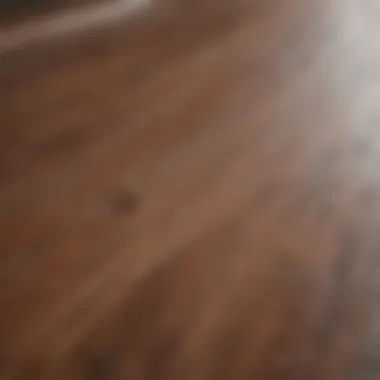
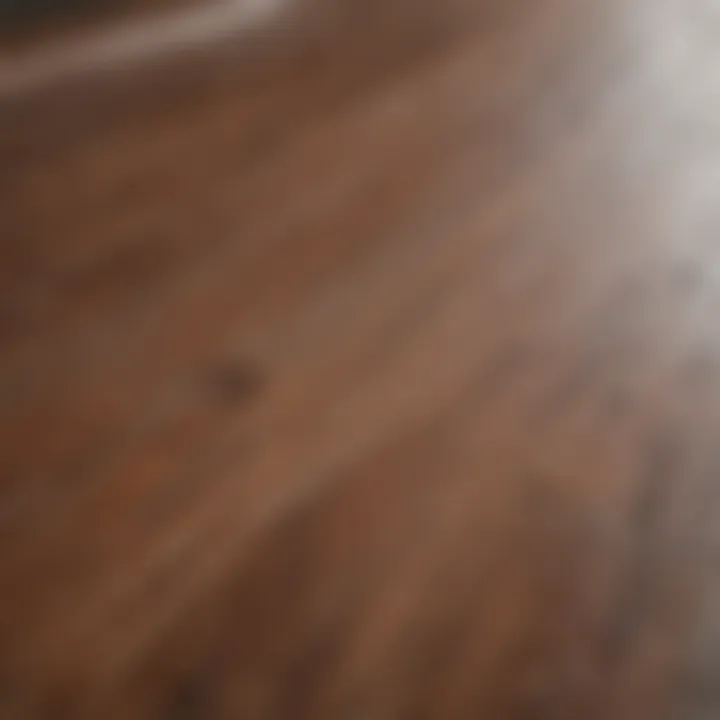
Intro
Painting finished wood furniture is an effective way to rejuvenate and personalize your living spaces. This approach allows homeowners to express their style through color and technique. However, the process requires careful consideration and planning. Understanding the necessary steps can ensure a successful transformation with minimal challenges.
This guide will cover everything from preparation to execution, providing insights into techniques and materials. Whether you are an interior design enthusiast or a casual DIYer, the information presented here will aid you in achieving a professional-looking finish.
Design Inspiration
Design inspiration establishes the foundation of any painting project. When considering a furniture makeover, current trends and color palettes play a crucial role in deciding the outcome.
Current Interior Design Trends
Design trends constantly evolve, influenced by cultural shifts, technology, and personal tastes. Currently, minimalistic designs with neutral colors dominate many homes. Shades like soft whites, beiges, and light grays create an airy feel and make the furniture a subtle centerpiece. On the other hand, bold colors such as deep blues and dark greens have emerged in popularity. These hues can add dramatic flair, especially when paired with light decor.
Additionally, you might want to consider seasonal trends. For example, earthy tones often resurface in the fall, while vibrant shades become popular in the spring. When selecting inspiration, examining your personal space and existing decor is key. Does your current color scheme provoke comfort, or does it need a refreshing upgrade?
Color Palettes and Their Effects
Selecting the right color palette is essential when painting finished wood furniture. Colors influence mood and style. Here’s a brief overview of a few popular color palettes:
- Monochromatic: This scheme utilizes shades of a single color, offering a harmonious and sophisticated look.
- Analogous: Using colors adjacent on the color wheel creates a cohesive and calming environment.
- Complementary: This approach pairs colors opposite each other on the wheel, delivering vibrant and dynamic contrasts.
Each palette appeals to different emotions and styles. For example, soft pastels impart relaxation, while bold tones can energize a space. Choosing a palette should be a thoughtful process, as it deeply impacts the overall aesthetic of your furniture and room.
"Color is the keyboard, the eyes are the harmonies, the soul is the piano with many strings."
—Wassily Kandinsky
To conclude this section, understanding design inspiration through current trends and color effects is crucial. It lays the groundwork for your furniture painting project, shaping the outcome into something uniquely your own.
Intro to Painting Finished Wood Furniture
Painting finished wood furniture is an engaging way to revitalize your living space. Many homeowners or interior design enthusiasts consider painting as a suitable solution to update the look of their furniture without spending a large sum on new pieces. This approach provides a unique opportunity to express personal style, while also enhancing the aesthetic appeal of various rooms.
The process of painting finished wood furniture involves several important considerations. Firstly, understanding the type of finish already present on the wood is crucial. Different finishes, such as varnishes, lacquers, or paints, require tailored preparation and application techniques for the new paint to adhere properly. Preparation is often the most time-consuming part of this project, yet it is vital for achieving a smooth and professional-looking result.
Another aspect to consider is the selection of paint. Not all paints work equally well with finished wood surfaces. Knowing what products are compatible with your furniture can save time and effort, preventing issues down the line such as peeling or bubbling.
Here are some benefits of painting finished wood furniture:
- Customization: Paint allows for the freedom to choose colors that fit your personal design aesthetic.
- Cost-Effectiveness: Refreshing existing furniture is usually more economical than buying new pieces.
- Sustainability: By upcycling furniture, you contribute to reducing overall waste.
"The outcome of this project not only enhances the visual appeal of your furniture but also reflects your individual taste and creativity."
In summary, painting finished wood furniture is both an art and a science. Proper understanding of the preparations and techniques involved can lead to a beautiful transformation that exceeds expectations. Whether you are an enthusiast or a novice, with the right guidance, anyone can achieve stunning results.
Understanding Finished Wood
Understanding finished wood is essential for any homeowner or enthusiast looking to successfully paint wooden furniture. This knowledge provides the foundation for making informed choices about materials, techniques, and desired outcomes. Preparedness in this area directly correlates to the quality of the final product.
Finished wood refers to wood that has been treated with a protective layer or coating to enhance its appearance and durability. This includes various types of finishes that serve different purposes, such as highlighting the natural grain or providing a barrier against moisture and wear. Knowing how these finishes behave is crucial when embarking on a painting project, as improper techniques can lead to subpar results.
The process of painting finished wood often involves more effort compared to unfinished wood. The coating can prevent paint from adhering properly, necessitating careful preparation. This article will detail approaches to overcoming these challenges, ensuring that your painting endeavor is both effective and satisfying.
Types of Wood Finishes
There are several types of wood finishes, and understanding these can influence your decision as you prepare to paint. Each finish offers distinct characteristics and benefits:
- Polyurethane: This is a common, durable finish that provides a tough coating. It is resistant to scratches and water but can be challenging for paint adhesion.
- Varnish: Known for its transparent finish, varnish adds shine and protection to wood. However, it may require extensive sanding for successful painting.
- Lacquer: Fast-drying and smooth, lacquer provides a clean and refined appearance. Still, it often repels paint, necessitating thorough preparation before application.
- Oil finishes: Such finishes like linseed or tung oils enhance the wood's natural characteristics but can pose challenges when applying paint, as they can remain greasy.
Choosing the right finish for your furniture impacts the approach you will take when painting.
Characteristics of Finished Wood
Recognizing the characteristics of finished wood helps in determining the appropriate methods for painting. Here are some important features to consider:
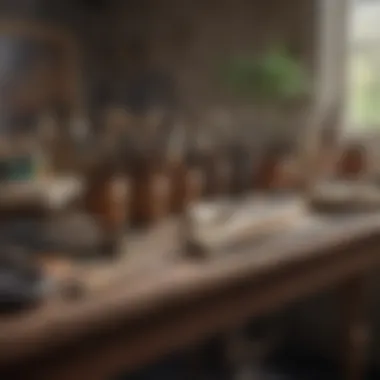
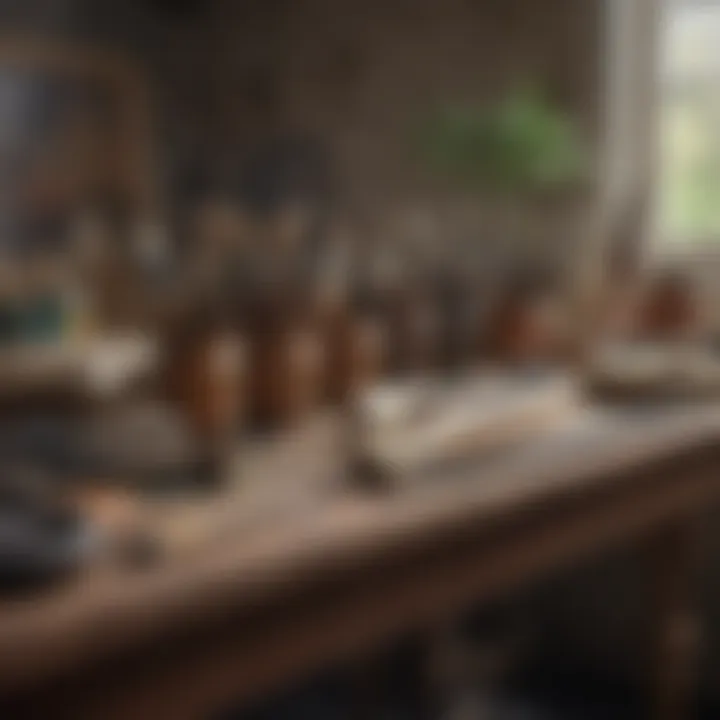
- Gloss levels: Different finishes come with varying gloss levels, from matte to high gloss. High-gloss finishes often require more preparation for paint adhesion.
- Surface texture: A smooth surface is typically beneficial for painting, while a rougher finish may require more attention to achieve an even result.
- Porosity: Finished wood can be non-porous, which makes it difficult for paint to grip. This emphasizes the need for cleaning and possibly sanding before applying any paint.
- Color consistency: Some finishes do not alter the base color of the wood significantly, while others can change the appearance dramatically, affecting how the final painted product looks.
Understanding these characteristics and how they influence the painting process ensures preparedness and increases the likelihood of achieving a satisfying result.
"Preparation is the key to success in any painting project, especially when dealing with finished wood furniture."
Equipped with this knowledge, you are better prepared for the stages of painting finished wood furniture, achieving the results you desire.
Assessing the Furniture Condition
Assessing the condition of your furniture is a crucial step before undertaking any painting project. This phase influences not only the aesthetic outcome but also the longevity and functionality of the paint job. By focusing on the existing state of the furniture, you can identify potential problems and determine the best course of action for preparing the surface.
When you assess the condition, consider various factors such as surface wear, structural integrity, and any type of damage. Doing this helps in making informed decisions about what needs to be done to achieve the desired finish. An uninformed approach can lead to unsatisfactory results, often necessitating redoing the work, which can be time-consuming and costly.
Identifying Damage and Wear
Start by closely inspecting your furniture to find any signs of damage. Look for scratches, dents, or areas where the finish has worn away. These imperfections can affect how paint adheres to the surface. If the wood is bare in some areas, it may soak up paint differently than in areas that are still finished. This can lead to an uneven appearance once the job is complete.
Additionally, check for structural issues such as loose joints or broken parts. If the furniture is unstable, it’s wise to repair those issues before painting. Only then can you ensure that your effort in painting will not be in vain. If you are uncertain how to fix these problems, consider consulting with a professional.
Determining the Type of Preparation Needed
After identifying the damage, you need to decide what preparations are necessary for the furniture. Different types of surfaces require different approaches. For example, if you found deep scratches or gouges, it might be necessary to fill them with wood filler. Ensure the filler matches the original wood to maintain an even finish.
For surfaces that are glossy or smooth, sanding may be needed to create a rough texture. This allows the primer and paint to adhere better. If significant wear is present, a thorough cleaning followed by sanding will prepare the wood properly. Choose a fine-grit sandpaper to avoid damaging the surface further.
In summary, assessing the condition of your finished wood furniture lays the groundwork for successful painting. It dictates the necessary preparation and repairs needed to achieve a professional-looking finish. Ignoring this step may lead to unsatisfactory results and wasted time.
Gathering Supplies for the Project
Proper preparation is crucial when painting finished wood furniture. Gathering the right supplies ahead of time not only streamlines the process but also enhances the overall quality of the result. A well-stocked workspace minimizes interruptions and allows for a smoother workflow. Additionally, having the appropriate tools and materials ensures that you can effectively tackle any challenges that may arise during the painting process.
Essential Painting Tools and Materials
To embark on your painting journey, it is vital to assemble a comprehensive collection of tools and materials. Essential items include:
- Sandpaper: A range of grits will help in smoothing the surface and preparing it for paint.
- Clean Cloths: These are necessary for wiping down surfaces to remove dust or residue before painting.
- Paint Brushes: Various sizes cater to different painting needs; a flat brush is great for broad areas, while a smaller brush allows for more precision around details.
- Paint Rollers: For larger surfaces, rollers can significantly speed up the process.
- Primer: This helps in enhancing adhesion and provides a better base for the paint. Depending on the finish, you might choose a water-based or oil-based primer.
- Paint: Selecting the right paint is crucial, depending on wood type and desired finish.
- Sealant or Topcoat: A final layer protects the painted surface from scratches and wear.
Organizing these supplies before starting your project not only simplifies your tasks but also instills a sense of readiness and control.
Paint Selection Based on Wood Type
Choosing the appropriate paint hinges on understanding the wood type you are dealing with. Different woods may react variously to paint, affecting adhesion, finish, and overall durability.
- Softwoods, such as pine or cedar, often absorb paint more readily. For them, consider using latex paints that allow flexibility as the wood expands and contracts.
- Hardwoods, including oak or maple, typically require a more durable paint, such as oil-based options. These paints promote a solid bond and provide a long-lasting finish.
- Stained Woods: If you wish to paint over a stained finish, you may need a specialized primer that seals the stain, preventing bleed-through.
It is also wise to consider the intended use of the furniture when selecting paint. For high-traffic pieces, such as tables or chairs, durable, washable finishes are advisable. This consideration ensures that your painted furniture not only looks good but also withstands daily wear and tear.
"Preparation and careful selection of materials can greatly influence the outcome of your furniture painting project."
Ultimately, the time taken to gather the right supplies will pay off, resulting in a project that is both satisfying and successful.
Preparation of the Wood Surface
Preparation of the wood surface is a critical stage in the process of painting finished wood furniture. It creates a foundation that influences both the aesthetic and durability of the final product. Skipping or skimping on preparation can lead to paint adhesion problems and uneven surfaces, resulting in a less than satisfactory finish. Therefore, understanding how to properly prepare the wood surface is essential for achieving a professional outcome.
An adequately prepared surface allows the paint to adhere effectively. This is crucial because if the paint does not bond well, it may peel or chip down the line. Additionally, a smooth, clean surface promotes an even coat of paint, reducing the likelihood of visible brush strokes or uneven color. Without proper prep work, the natural characteristics of the wood can hinder the painting process.
Cleaning the Surface
Cleaning the surface of furniture is an essential first step. Dust, dirt, and grease can accumulate on finished wood. Neglecting to remove these contaminants results in poor paint adhesion and an unappealing final appearance. A simple cleaner or a mixture of mild soap and water can work effectively. A soft cloth or sponge should be used to gently scrub the surface. After cleaning, it is crucial to dry the surface thoroughly. Moisture can also affect paint adherence.
"A clean surface is the first step toward a great finish."
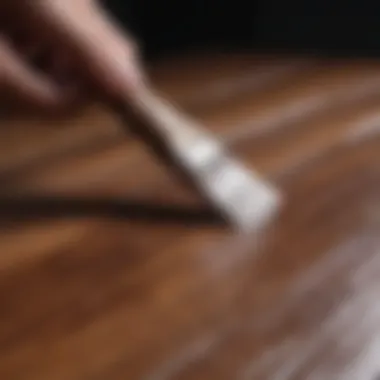
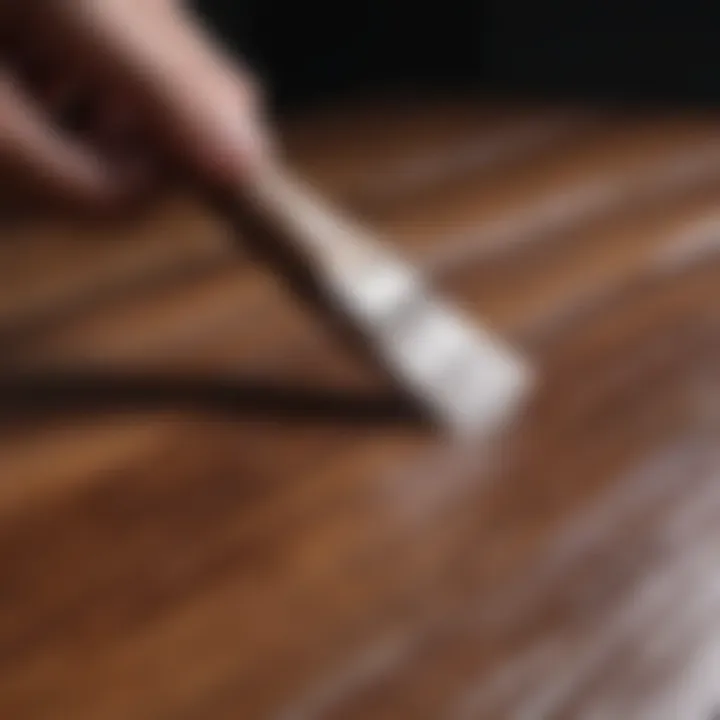
Sanding Techniques
Sanding is the next integral component of surface preparation. It helps in smoothing out imperfections, removing any existing finish, and making it easier for the paint to stick. Different grits of sandpaper serve various purposes:
- Coarse grit (60-80): Useful for removing an old finish or imperfections.
- Medium grit (120-150): Ideal for smoothing rough patches.
- Fine grit (180-220): Recommended for a final smooth finish before painting.
When sanding, move with the wood grain to prevent scratches that could show through the paint. Always wipe down the surface afterward to remove any dust created during sanding. This ensures a clean area for primer application.
Applying Primer for Optimal Adhesion
The application of primer is often a game-changer for painted furniture. Primer enhances adhesion, solidifies color, and reduces the number of paint coats required for uniform coloring. It acts as a barrier that helps the paint bind better to the surface.
Select a primer that is compatible with the chosen paint type. A water-based primer is suitable for water-based paints, while oil-based primers pair well with oil-based paints. Make sure to apply an even coat. Allow it to dry completely before applying the paint. This step is critical, as a poorly applied primer can lead to uneven surfaces and color inconsistencies.
In summary, preparation of the wood surface plays a pivotal role in the painting process. Taking the time to clean, sand, and prime will foster an environment for achieving an exceptional finish, transforming your finished wood furniture into something truly striking.
Application Techniques for Painting
Application techniques are crucial when painting finished wood furniture. They not only affect the visual appeal of the piece but also determine the durability of the paint job. Proper techniques can help achieve smooth and even surfaces, avoiding issues like brush strokes or drips. Furthermore, knowing which application method suits your project helps in selecting the right tools, minimizing time spent on corrections and touch-ups.
In this section, we will explore two primary application methods: brush and spray painting. Each has its own advantages and challenges, making it essential to choose wisely based on the specific project and personal preferences.
Brush vs. Spray Painting
Brush painting is a traditional method that allows for detailed work. It is ideal for intricate designs and smaller surfaces. Brushes come in various sizes and types, leting painters select the best option for their needs. A key benefit of using a brush is the control it offers over paint application. You can navigate tight corners and edges, ensuring a consistent finish without overspray. However, using a brush also requires careful technique to avoid leaving behind visible strokes.
Spray painting, on the other hand, is a quicker method suited for larger areas. It allows for an even application and can reduce labor time significantly. Sprayers can cover a broad surface area in a short period. This method minimizes brush marks and offers a smooth finish. However, spray painting can lead to overspray and requires sufficient workspace and protective measures, like tarps or drop cloths, to shield surrounding areas.
Ultimately, the choice between brush and spray painting depends on the project requirements and the desired end result. A combination of both methods may also be effective, using a spray for broad areas and a brush for detailed work.
Layering and Drying Times
Layering paint is essential for achieving depth and richness in color. It involves applying multiple thin coats rather than one thick layer. Thin layers typically dry faster, reducing the risk of runs and drips. Allowing adequate drying time between coats is critical to avoid uneven surfaces.
Each type of paint has different drying times, which can be impacted by humidity and temperature. Oil-based paints usually take longer to dry compared to water-based options. For optimal results, consult the paint manufacturer's guidelines on recommended drying times. Generally, waiting at least two to four hours between coats is advisable, keeping environmental factors in mind.
Once the last layer has been applied, allow the paint to cure fully. This can take several days or even weeks, depending on the materials used. Curing allows the paint to reach maximum hardness, which will improve durability against wear and tear over time.
"Applying thin, even coats and allowing proper drying time are fundamental principles for a lasting paint finish."
Following these techniques will enhance the overall quality and lifespan of your painted furniture, ultimately elevating its aesthetic value.
Finishing Touches After Painting
In the process of painting finished wood furniture, the finishing touches are paramount. They not only enhance the aesthetic appeal of the pieces but also ensure their longevity and durability. Completing the painting project with careful consideration of these last steps can significantly change how the furniture looks and feels in your home.
Applying the right sealants and top coats is crucial. These products create a protective barrier against scratches, moisture, and stains, which can be particularly damaging to painted surfaces. A top-quality sealant also helps the paint to maintain its vibrancy over time.
When selecting sealants and top coats, consider both the finish you desire and the type of paint used. For example, if you used a water-based paint, a water-based top coat will typically provide the best adhesion and finish. Alternatives such as oil-based sealants may be suitable for different contexts, especially where extra durability is needed.
Sealants and Top Coats
Sealants are protective coatings applied over the paint to prevent damage. They can be categorized into several types, including:
- Polyurethane: Offers high durability and is available in both water-based and oil-based formulas. It is excellent for furniture that will undergo frequent use.
- Varnish: Provides a hard finish and is typically used for oak or mahogany wood. It works well on items that require a long-lasting sheen.
- Shellac: A natural option that works effectively for craft projects, offering a traditional finish.
Applying these products can be straightforward, but proper technique is critical. To ensure an even coat, use a high-quality brush or a spray applicator, depending on the desired effect. Always follow the manufacturer’s instructions regarding application techniques and curing times for optimal results.
Final Inspection and Adjustments
After the sealant has cured, a thorough final inspection is essential. This stage allows you to identify any imperfections or areas that may need touch-ups. Common issues include uneven paint application or dust particles trapped in the finish.
If you spot any flaws:


- Use fine-grit sandpaper to lightly smooth out any rough spots.
- Wipe down the surface with a damp cloth to remove dust before making touch-ups.
- Apply a small amount of paint to correct any areas needing enhancement, allowing it to dry before evaluating again.
Additionally, consider evaluating the structure of the furniture. Ensure that all components are secure and functioning correctly. Hinges, drawers, and slides should operate smoothly, and any adjustments necessary for their function should be made promptly.
By paying attention to these finishing touches, your painted furniture will not only look great but also withstand the test of time in your living space.
Maintaining Painted Furniture
Maintaining painted furniture is vital for preserving its appearance and extending its lifespan. Regular care ensures that the investment in your furniture pays off over time. Painted surfaces can undergo wear and tear from daily use, making it essential to adopt a routine that protects their beauty. Furthermore, understanding how to maintain these surfaces enhances the durability of the paint and can prevent significant repairs down the road.
Cleaning and Caring for the Finish
Keeping painted furniture clean is a primary component of maintenance. Dusting with a soft, dry cloth should be a part of your regular cleaning routine. This prevents dust buildup, which can dull the finish over time. For more thorough cleaning, a damp cloth may be used, but it's crucial to avoid soaking the wood, as excess moisture can lead to damage.
When stains occur, they should be treated promptly. Use a mild soap diluted in water, applying it gently with a cloth. Avoid abrasive cleaners, as they can scratch the painted surface, leading to peeling and chipping. After cleaning, it's a good practice to dry the surface completely to prevent water from settling into any small cracks in the finish.
"Routine care is key. A little attention goes a long way in preserving your furniture's aesthetic and integrity."
To maintain the luster of the paint, consider applying a polish designed for painted surfaces every few months. This not only replenishes shine but also creates a protective layer that repels dirt and moisture. Additionally, avoid placing hot items directly on the painted surface, as the heat could compromise the finish, leading to discoloration.
Repairing Minor Scratches and Nicks
Scratches and nicks are inevitable, even on the best-painted furniture. However, addressing these imperfections promptly can prevent them from worsening. Start by assessing the damage carefully. For minor scratches, a touch-up pen that matches the paint color can be effective. Simply apply a small amount following the grain of the wood, and allow it to dry completely.
For deeper scratches or nicks, the use of a fine-grit sandpaper may be necessary to smooth the area. After sanding, clean the dust away and then apply a matching paint or touch-up solution. Make sure the new application is feathered at the edges to blend seamlessly with the existing finish. Allow adequate drying time as indicated by the manufacturer’s instructions.
In cases where damage is more severe, such as deeper gouges, a filler designed for painted furniture may be needed. Apply the filler carefully, shaping it to match the surrounding surface, and once it has dried, sand lightly before repainting to ensure continuity in texture.
Continuing the careful maintenance of your painted furniture enhances not only its visual appeal but also its functional longevity, ensuring that your home remains a sanctuary of style and comfort.
Common Challenges and Solutions
Painting finished wood furniture presents its own set of unique challenges. Understanding these potential issues is essential for achieving the best results. Homeowners and enthusiasts often expect a smooth application and flawless finish. However, without foresight, they might experience uneven textures, peeling paint, or other suboptimal outcomes. By proactively identifying common challenges and their solutions, one can significantly enhance the quality of the painting project.
Dealing with Uneven Finishes
Uneven finishes are a common issue faced during painting. This problem often arises from improper application techniques or insufficient surface preparation. Uneven coverage can detract from the beauty of a piece and may require additional work to correct.
To avoid this, several steps should be taken:
- Proper Surface Preparation: Ensure that the wood surface is clean and smooth before painting. Sanding not only removes imperfections but also enhances paint adhesion.
- Use Quality Tools: A high-quality brush or spray gun can make a significant difference. These tools help distribute paint evenly over the surface.
- Apply Thin Layers: Rather than applying a thick coat, use thin layers of paint. This approach reduces the likelihood of drips and allows for more control over the finish.
- Check Lighting: Painting in proper lighting is crucial. It allows the painter to observe any uneven areas as they work.
"A little bit of extra attention to detail during preparation can save a lot of trouble later on."
If uneven finishes do occur, it is often necessary to sand down the affected area and reapply the paint to achieve a uniform look. This step, while tedious, ensures that the final appearance meets expectations.
Addressing Paint Peeling
Paint peeling is another frequent concern that can be quite frustrating. This issue usually indicates a problem with either the existing finish or the paint itself. Peeling can happen when the paint does not bond well with the surface, often due to inadequate preparation or moisture issues.
To mitigate this challenge, consider the following:
- Inspect the Existing Finish: Before painting, examine the current finish. If it is too shiny, it may require additional sanding or primer to help the new paint adhere.
- Choose the Right Paint: Using paint specifically designed for furniture or for the type of finish on the wood can improve adhesion and durability.
- Control the Environment: Moisture levels can affect paint adhesion. Ensure the area is dry and well-ventilated during the painting process.
- Allow for Proper Curing Time: After painting, follow the manufacturer's recommendations regarding curing times. Allowing the paint to cure properly can prevent future peeling.
Addressing peeling promptly is crucial. If peeling occurs after the paint has dried, the affected area should be stripped back to the bare wood. Apply a suitable primer and repaint to restore the integrity of the furniture's appearance.
By recognizing these common challenges and implementing effective strategies, the painting process can become smoother and more efficient. Knowledge is a vital asset in ensuring that the finished product aligns with one's initial vision.
Culmination
First, proper preparation is vital. It ensures that the paint adheres well and that the furniture surface is ready for transformation. Failure to prepare can result in uneven finishes and peeling paint.
Secondly, technique matters. Different application methods, such as brush or spray painting, affect how the final look will appear. It is crucial to know when to use each method based on the furniture's shape and the desired effect.
Moreover, selecting the right materials enhances both durability and aesthetics. Choosing high-quality paint and sealants allows for long-lasting results.
Lastly, maintaining painted furniture prolongs its life and beauty. Simple care routines make a significant difference in preserving the work done in the painting phase.
"Taking the time to prepare, choose the right materials, and maintain the painted surface leads to a successful transformation of wooden furniture."
By synthesizing these aspects successfully, individuals can navigate potential challenges, achieving professional-looking outcomes. Therefore, this guide provides valuable insights into a seemingly straightforward task that involves care, knowledge, and skills. Readers now possess the tools and understanding necessary to confidently undertake their furniture painting projects.















